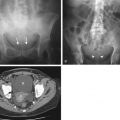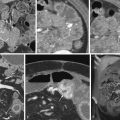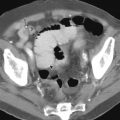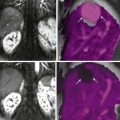Chapter Outline
Magnetic Resonance Angiography Techniques
Image Postprocessing and Display
Clinical Applications of Abdominal Magnetic Resonance Angiography
Magnetic Resonance Angiography Pitfalls
Magnetic resonance angiography (MRA) is a noninvasive technique that has been used as an alternate to conventional angiography. Noncontrast and contrast-enhanced techniques have been used historically to evaluate the visceral vessels. The most widely used noncontrast methods include time-of-flight (TOF) and phase contrast (PC) MRA, which have been validated most extensively for renal MRA. Advances in MR technology have facilitated the implementation of three-dimensional, contrast-enhanced MRA (CE MRA), which significantly expanded the role of MR angiography in imaging of the abdomen. New developments have led to time-resolved, contrast-enhanced MRA, which in addition to providing static arterial or venous phase images, provides hemodynamic information by allowing multiple rapid 3D acquisitions during the first pass of contrast. In addition, blood pool gadolinium contrast allows for steady-state imaging of the aorta and visceral vessels. In this chapter, we briefly discuss the various MR angiographic techniques, with emphasis on contrast-enhanced MR angiography. Included are approaches to patient preparation, imaging protocols, and image postprocessing techniques used in the evaluation of visceral vasculature with MRA. Various clinical applications of MRA in the abdomen are illustrated through a discussion of specific disease entities.
Magnetic Resonance Angiography Techniques
Nonenhanced Magnetic Resonance Angiography Techniques
Time-of-Flight
Time-of-flight (TOF) is the oldest MRA technique for the evaluation of vasculature. This technique exploits blood motion to visualize vascular structures directly without the use of intravenous contrast material. It is performed using a gradient-refocused sequence in which the stationary tissues are saturated, resulting in low background signal intensity. In contrast, the blood moving into the imaging volume is unsaturated, with full longitudinal magnetization, which when excited gives a bright signal compared to the stationary, saturated background tissues. There are limitations with the TOF technique. The most important is that TOF is time- consuming and requires patient cooperation. Long acquisition times limit its use during a breath-hold. In addition, this technique is susceptible to in-plane saturation and phase dispersion, preventing the application of TOF for routine evaluation of the visceral vasculature. TOF may still provide diagnostic images in the evaluation of large vessels such as the abdominal aorta, proximal portions of the celiac and superior mesenteric arteries, large venous structures such as the inferior cava (IVC), portal vein, superior mesenteric vein, and portosystemic collaterals. Diseased vessels or small arteries such as the proper hepatic, gastroduodenal, and branches of the superior mesenteric arteries are not well evaluated with this technique. The direction of portal venous blood flow can be assessed using the TOF technique by simply applying a saturation band over the portal vein. Contrast-enhanced and nonenhanced techniques have mainly replaced TOF imaging in the abdomen.
Phase Contrast Technique
The phase contrast (PC) technique uses phase shifts of the flowing protons in the vascular structures to create MRA images. Phase shifts of stationary tissues are compensated by using bipolar gradient. Two imaging acquisitions are performed, in which the first has a positive bipolar gradient and the second has a negative bipolar gradient. The data from these two acquisitions are subtracted in k space to eliminate phase shift induced by other sequence parameters. The net effect is an image of flowing spins. The amount of phase difference that remains after subtraction is proportional to the velocity of the moving spins. The flow sensitivity can be adjusted by setting the velocity encoding value, V(enc). V(enc) determines the highest and lowest detectable velocities encoded by a phase-contrast sequence. For example, V(enc) = 100 cm/s is ideal for a phase contrast MRA with a measurable range of flow velocities of ±100 cm/s. PC MRA allows for the functional assessment of mesenteric circulation and has been shown to be helpful for diagnosing mesenteric ischemia. The information from phase contrast measurements can be processed into magnitude (bright blood and anatomic) images or phase contrast (velocity) images. A major disadvantage of the PC technique is long acquisition times, requiring patient cooperation. Because the final image relies on subtraction, patient motion can be problematic. Turbulent flow distal to a region of stenosis may result in dephasing and signal loss, overestimating the stenosis grade. As a result of these many limitations, this technique is not typically used as a primary imaging tool for anatomic assessment of the visceral arteries or portal system.
Balanced Steady-State Free Precession
Balanced steady-state free precession (b-SSFP) is a rapid imaging technique that provides a very high signal-to-noise ratio with T2 * /T1-weighted image contrast. The different T2 * /T1 ratios of blood and surrounding tissue are beneficial for angiographic imaging. This technique is not flow-dependent, so venous structures demonstrate as bright a signal intensity as arterial structures. Clotted blood is low in signal intensity, depending on the clotting stage and composition of blood products. b-SSFP is best suited for morphologic imaging of the vessels. It allows a rough anatomic preview and visualization of background tissues, such as mural thrombus and vascular wall, which may not be optimally evaluated when using a contrast-enhanced MRA sequence alone. The drawback of this technique is the banding artifacts caused by magnetic field inhomogeneity. One solution to this problem is to use a very short repetition time (TR) to eliminate the artifacts from the regions of interest. Given the high signal-to-noise ratio of b-SSFP sequences, the bright signal intensity of fat can obscure anatomic structures. In such cases, effective fat suppression can be used to improve the image quality.
Other Techniques
Other procedures for noncontrast MRA are available, such as fresh blood imaging (FBI), NATIVE, and flow prep, which are based primarily on electrocardiogram (ECG), gated, fast spin-echo (FSE) sequences. This general technique relies on high signal during diastole and flow void during systole within the arteries secondary to differential velocity, which allows for images depicting only arteries or veins following subtraction. Although in principle this technique seems simple, it requires expertise on the part of the technologist and, because it relies on differential flow between systole and diastole, it does not perform well in the setting of severe disease. ECG-gated FSE sequences have been used primarily for peripheral vascular disease and aortic imaging, with little published experience in mesenteric imaging.
In addition to ECG-gated FSE sequences, another new technique is the quiescent-interval single-shot (QISS) sequence. This has demonstrated promise for peripheral vascular disease and also may be used to image the abdominal aorta and origins of the major visceral vessels. QISS is an ECG-gated slice selective 2D b-SSFP sequence that uses a tracking saturation pulse to eliminate venous signals. Images are acquired during the quiescent interval, coinciding with arterial inflow during systole. This new technique has yet to be thoroughly tested for application in mesenteric MRA.
Contrast-Enhanced Magnetic Resonance Angiography Techniques
CE MRA is the preferred MR technique for anatomic evaluation of the arterial and venous systems in the abdomen and pelvis. The image contrast is based on the differences in the T1 relaxation time of blood and the surrounding tissues. Gadolinium chelate is administered to significantly shorten the T1 relaxation time of blood and T1-weighted images are obtained, often with precontrast images obtained for reference and subtraction. Conventional 3D CE MRA techniques requiring bolus timing often provide good anatomic detail. Time-resolved techniques minimize the need for bolus timing and allow for the assessment of flow dynamics using high temporal resolution. Steady state high resolution imaging with blood pool agents can provide exquisite anatomic detail not previously attainable with extracellular agents.
Conventional Three-Dimensional Contrast-Enhanced Magnetic Resonance Angiography
CE MRA requires bolus timing with pre- and postcontrast 3D spoiled gradient-echo technique (3D SPGR/3D fast low-angle shot [FLASH]) using very short echo times (TEs) and repetition times (TRs) in combination with a relatively high excitation flip angle (25 to 40 degrees). No special preparation for the scan is required. Some studies indicate that a mesenteric MRA is better performed postprandially because there is increased splanchnic circulation.
After the patient is positioned supine on the table and centered for the midabdomen, the basic imaging protocol for mesenteric MRA generally starts with multiplane scout images of the abdomen. Coronal and axial true fast imaging with steady-state precession (FISP; balanced SSFP) images of the abdomen are acquired to provide anatomic assessment of the outer wall of the vessel and an additional set of localizers to position the subsequent test bolus and 3D MRA slab. A precontrast 3D MRA sequence is performed in the coronal plane for most applications; consider sagittal for celiac and superior mesenteric pathologies such as the median arcuate ligament or superior mesenteric artery (SMA) syndrome. To achieve the best image quality, use the shortest possible TR to shorten the acquisition time and a minimized TE to decrease the dephasing artifact and T2 * effects. An appropriate flip angle is between 25 and 40 degrees. The thicknesses of slabs and sections vary, depending on the patient, to cover all the mesenteric vessels, including the hepatic arteries, superior mesenteric arteries, and branches. One should aim for a slice thickness of 1 to 1.5 mm after interpolation; however, for larger vessels, thicker slices may be sufficient and allow greater coverage.
If using the test bolus technique (see later), a timing bolus sequence (turbo FLASH sequences: acquisition speed = 1 image/s) of the abdominal aorta is performed in the sagittal plane using a test injection of gadolinium chelate (≈1-2 mL, injected at a rate of 2-3 mL/s). If there is an aortic aneurysm, the estimated contrast arrival time should be timed at the distal part of the aneurysm. After the administration of contrast (0.1-0.2 mmol/kg, 2-3 mL/s) at an appropriate delay time (as calculated, or automatically triggered) followed by a saline flush solution of 15 to 20 mL at the same rate, two imaging sets are consecutively acquired postcontrast. The imaging time for each sequence should be less than 20 to 25 seconds to permit breath holding.
Contrast Material Dosage and Injection Rate.
Appropriate timing of contrast material injection is critical in obtaining a good conventional 3D CE MRA, without significant venous contamination, for evaluation of the arterial system. The volume of contrast material and chasing saline solution, delivery rate, and scan delay time are important parameters that are to be adjusted to optimize image quality.
The arterial and venous enhancement pattern after the rapid contrast injection is shown in Figure 10-1 . To achieve excellent image contrast and signal-to-noise ratio, the imaging sequence has to be timed so that the acquisition of the central portion of the k space (low-frequency data lines) corresponds with the plateau phase of maximum concentration of contrast material in the vessels of interest. If the central portion of the k space is filled prior to the peak of the contrast concentration, ringing or banding artifacts occur ( Fig. 10-2 ). However, if images are acquired too, late venous contamination may obscure the arterial anatomy.


Injection rate and duration of injection also have a significant effect on the pattern of arterial enhancement. A faster injection rate leads to a sharper arterial peak and higher maximum arterial signal intensity, whereas a slower injection rate results in a lower and broader arterial peak and lower maximum arterial signal intensity. Contrary to the arterial enhancement pattern, the degree of venous enhancement does not vary substantially with the injection rate but primarily depends on the total dose of contrast material when using an extracellular contrast agent. Thus, a larger amount of contrast material leads to higher intravascular signal intensity when performing gadolinium-enhanced portography or venography. The time to peak for venous enhancement is longer with a slower injection rate, and image acquisition should be delayed proportionally to obtain the best contrast enhancement in the venous structures.
As the technique of CE MRA imaging was first introduced, the images were acquired as non–breath-holds, with acquisition times of 3 to 5 minutes. Under these circumstances, the gadolinium chelate was preferably infused at a slow uniform rate over the entire scan duration to prolong the window of preferential arterial to venous enhancement. Now, high-speed gradient MR systems and improved sequences permit shorter acquisition times, typically shorter than 20 seconds, which allows data acquisition during the first pass of contrast material in a single breath-hold. Therefore a rapid bolus injection with an automatic MR-compatible power injector is preferred.
Many different approaches have been used to optimize the injection rate and dosage of contrast material for MR angiography. The dosage of extracellular contrast agents used for performing abdominal MR angiography usually varies from a single to a triple dose (0.1 to 0.3 mmol/kg). Although some studies have shown that a single dose of contrast is sufficient for diagnostic assessment of the aorta and its major branches with CE MRA, some investigators have reported that image quality, vessel delineation, and confidence in diagnosis improve with the use of a higher dose (double or triple dose ). However, double- and triple-dose methods have fallen out of favor because of the association of nephrogenic systemic fibrosis with gadolinium contrast agents. With regard to injection rate, a faster injection allows for a greater degree of preferential arterial to venous enhancement, and the interval between arterial and venous peaks tend to be longer with a higher injection rate. Hence, venous contamination is diminished with a high-rate injection protocol. For mesenteric MRA, we use a single dose and inject at a rate of 2 to 3 mL/s, followed by a 20-mL normal saline flush at the same rate.
Bolus Timing Methods.
Because the image quality of CE MRA depends primarily on the distribution and concentration of gadolinium during the acquisition of the center of the k space, proper timing is paramount to achieving a good MRA image, particularly when using fast imaging techniques. There are several ways to synchronize the arterial peak enhancement with the center of k space data acquisition.
“Best Guess” Technique.
This is the simplest timing method; it is performed by using an estimated contrast travel time from the injection site to the vascular structure of interest with sequential (linear) order of k space acquisition. The variation in contrast travel time depends on age, gender, injection site, injection rate, and other clinical parameters, such as cardiac output status and vascular anatomy. In general, the estimated contrast travel time from an antecubital vein to the abdominal aorta is approximately 15 to 18 seconds in a healthy young patient and 20 to 25 seconds in a healthy older patient. In patients with decreased cardiac output or a large aortic aneurysm, the estimated contrast travel time may vary widely, from 25 to 50 seconds.
Test Bolus Technique.
This is a more precise timing method performed by injecting a small amount of contrast material (1 to 2 mL) followed by normal saline flush (10 to 20 mL) at the same injection rate as in the planned contrast-enhanced MRA study. The vascular structure of interest is imaged with a timing bolus acquisition (single-slice, fast 2D gradient-echo sequence) acquired at a rate of one image every second. Time to peak of contrast enhancement is determined visually or by drawing a region of interest over the vessel. when using a sequential (linear) order of k space acquisition in the 3D MRA sequence, the scan delay time is calculated as follows:
Imaging delay time or scan delay = ( time to peak of contrast enhancement ) + ( injection duration time/ 2 ) − ( time to center of k space )
Stay updated, free articles. Join our Telegram channel

Full access? Get Clinical Tree








